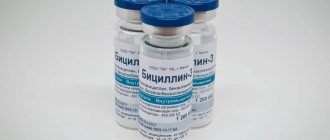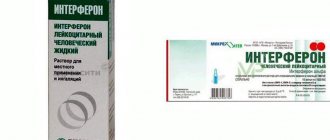Contraindications
There are a lot of contraindications to the use of the drug, which must be taken into account when treating pain. Thus, Xefocam is contraindicated for use in the following conditions:
- Bronchial asthma, especially in combination with nasal polyposis, intolerance to acetylsalicylic acid, including a history of it.
- High risk of bleeding (blood clotting disorders, bleeding diathesis, persons who have undergone major operations associated with the risk of incomplete hemostasis, such as CABG).
- Peptic ulcer of the ventricle and duodenum.
- Active bleeding of any location.
- Bleeding localized in the gastrointestinal tract, with an established relationship with the use of non-steroidal drugs according to the anamnesis.
- Crohn's disease in the acute phase.
- Nonspecific ulcerative colitis in the acute phase.
- Decompensated cardiovascular pathology.
- End-stage renal (with creatinine level more than 300 µmol/l) or liver failure.
- Hepatitis with pronounced enzymatic activity.
- Progressive kidney diseases.
- High level of hyperkalemia (more than 7 mmol/l).
- Pregnancy.
- Lactation.
- Children under eighteen years of age.
- Allergic reactions to taking the drug and intolerance to the drug and its components.
In this case, the drug is used with caution in renal and/or liver failure of moderate severity, in persons over 65 years of age, with severe cerebrovascular diseases, with diabetes mellitus and lipid metabolism disorders, while taking anticoagulants, SSRIs, glucocorticosteroids, with severe somatic diseases, smoking, alcoholism.
Buy Xefocam tablets p.o 8 mg No. 10 in pharmacies
INSTRUCTIONS for medical use of the drug XEFOCAM
Registration number
Trade name of the drug Xefocam
International nonproprietary name Lornoxicam
Dosage form Film-coated tablets
Composition per 1 tablet for a dosage of 4 mg. Active substance: lornoxicam - 4 mg. Excipients: magnesium stearate 2.0 mg, povidone (K25) 5.0 mg, croscarmellose sodium 10.0 mg, cellulose 85.0 mg, lactose monohydrate 94.0 mg. Shell: macrogol (6000) 1.2 mg, titanium dioxide E-171 2.4 mg, talc 4.8 mg, hypromellose 8.4 mg.
Composition per 1 tablet for a dosage of 8 mg. Active substance: lornoxicam - 8 mg. Excipients: magnesium stearate 2.0 mg, povidone (K25) 5.0 mg, croscarmellose sodium 10.0 mg, cellulose 85.0 mg, lactose monohydrate 90.0 mg. Shell: macrogol (6000) 0.8 mg, titanium dioxide E-171 1.6 mg, talc 3.2 mg, hypromellose 5.6 mg.
Description White to yellowish oblong film-coated tablets, inscribed with “LO4” (4 mg dosage) and “LO8” (8 mg dosage) indented.
Pharmacotherapeutic group Non-steroidal anti-inflammatory drug (NSAID).
ATX code: M01AC05
Pharmacological action Has a pronounced analgesic and anti-inflammatory effect. Lornoxicam has a complex mechanism of action, which is based on the suppression of prostaglandin synthesis due to inhibition of the activity of cyclooxygenase isoenzymes. In addition, lornoxicam inhibits the release of oxygen free radicals from activated leukocytes. The analgesic effect of lornoxicam is not associated with narcotic effects. The drug XEFOCAM does not have an opiate-like effect on the central nervous system and, unlike narcotic analgesics, does not depress respiration and does not cause drug dependence. Pharmacokinetics Lornoxicam is rapidly and almost completely absorbed from the gastrointestinal tract after oral administration. In this case, maximum plasma concentrations are reached after approximately 1-2 hours. Eating reduces the maximum concentration (Cmax) by 30% and increases the time to reach the maximum concentration (Tmax) to 2.3 hours. The absolute bioavailability of lornoxicam is 90-100%. Lornoxicam is present in plasma mainly unchanged and, to a lesser extent, in the form of a hydroxylated metabolite, which has no pharmacological activity. The binding of lornoxicam to plasma proteins, predominantly the albumin fraction, is 99% and does not depend on its concentration. The half-life averages 4 hours and does not depend on the concentration of the drug. Lornoxicam is completely metabolized in the liver. CYP2C9 is involved in metabolism. Approximately 1/3 of the metabolites are excreted from the body by the kidneys and 2/3 by the bile. In elderly people, as well as in patients with renal or hepatic insufficiency, no significant changes in the pharmacokinetics of lornoxicam were found.
Indications for use : Short-term treatment of pain of various origins. Symptomatic treatment of rheumatic diseases (rheumatoid arthritis, osteoarthritis, ankylosing spondylitis, articular syndrome with exacerbation of gout, rheumatic soft tissue damage).
Contraindications - Known hypersensitivity/allergy to lornoxicam or to one of the components of the drug; - complete or incomplete combination of bronchial asthma, recurrent nasal polyposis or paranasal sinuses and intolerance to acetylsalicylic acid and other NSAIDs (including a history); - hemorrhagic diathesis or bleeding disorders, as well as those who have undergone operations associated with the risk of bleeding or incomplete hemostasis; — the period after coronary artery bypass grafting; - erosive and ulcerative changes in the mucous membrane of the stomach or duodenum, active gastrointestinal bleeding; cerebrovascular or other bleeding; - recurrent gastric ulcer or repeated gastrointestinal bleeding; - Gastrointestinal bleeding associated with a history of taking NSAIDs; - inflammatory bowel diseases (Crohn's disease, ulcerative colitis) in the acute phase; - decompensated heart failure; - severe liver failure or active liver disease; - severe renal failure (serum creatinine level more than 300 µmol/l), progressive kidney disease, confirmed hyperkalemia, hypovolemia or dehydration; — pregnancy, breastfeeding period; - childhood .
With caution Erosive and ulcerative lesions and bleeding from the gastrointestinal tract (history), moderate renal failure, conditions after surgical interventions, age over 65 years, body weight less than 50 kg, coronary heart disease, heart failure, cerebrovascular diseases, dyslipidemia/hyperlipidemia, diabetes mellitus, peripheral arterial diseases, smoking, creatinine clearance less than 60 ml/min, a history of ulcerative lesions of the gastrointestinal tract, the presence of H. pylori infection, long-term use of NSAIDs, alcoholism, severe somatic diseases, simultaneous use of oral corticosteroids (including prednisolone), anticoagulants ( including warfarin), antiplatelet agents (including clopidogrel), selective serotonin reuptake inhibitors (including citalopram, fluoxetine, paroxetine, sertraline).
Method of administration and dosage For oral administration: for severe pain, the recommended dose is 8-16 mg/day, divided into 2-3 doses. The maximum daily dose is 16 mg. For inflammatory and degenerative rheumatic diseases, the recommended starting dose is 12 mg. The standard dose is 8-16 mg per day, depending on the patient's condition. The duration of therapy depends on the nature and course of the disease. XEFOCAM tablets are taken orally before meals with a glass of water. For diseases of the gastrointestinal tract, patients with impaired renal or liver function, and elderly people (over 65 years of age), it is recommended to use the minimum effective dose of the drug in the shortest possible short course. The maximum daily dose is 12 mg, divided during the day into 3 doses of 4 mg.
Side effects From the gastrointestinal tract and liver: dyspepsia, abdominal pain, dry mouth, stomatitis, nausea, vomiting, heartburn, diarrhea; esophagitis, gastritis, erosive and ulcerative lesions of the mucous membrane of the stomach and intestines, incl. with perforation and bleeding, constipation, flatulence, melena, impaired liver function, increased levels of liver transaminases; From the nervous system: headache, dizziness, drowsiness, sleep disturbances, depression, agitation, tremor, aseptic meningitis, paresthesia; On the part of the skin and subcutaneous fat: edematous syndrome, ecchymosis, skin rash, itching, urticaria, alopecia, Stevens-Johnson syndrome, Lyell's syndrome; From the urinary system: dysuria, decreased glomerular filtration, interstitial nephritis, glomerulonephritis, papillary necrosis, nephrotic syndrome, peripheral edema, acute renal failure; From the senses: tinnitus, blurred vision; From the cardiovascular system: development or worsening of heart failure, tachycardia, increased blood pressure; From the hematopoietic organs and hemostasis system: agranulocytosis, leukopenia, anemia, thrombocytopenia, increased bleeding time; From the respiratory system: pharyngitis, rhinitis, dyspnea, cough, bronchospasm; Other: anorexia, increased sweating, changes in body weight, arthralgia, myalgia, angioedema.
Overdose Symptoms: the side effects of XEFOCAM described above may increase. Treatment: symptomatic. Taking activated carbon immediately after taking XEFOCAM may help reduce the absorption of this drug. Antiulcer drugs can be used to prevent damage to the mucous membrane.
Interaction with other drugs The simultaneous use of XEFOCAM and cimetidine increases the concentration of lornoxicam in plasma. No interactions with ranitidine and antacid drugs have been identified; anticoagulants or platelet aggregation inhibitors - possible increase in bleeding time (increased risk of bleeding, INR control is required); beta-blockers and angiotensin-converting enzyme inhibitors may reduce their hypotensive effect; diuretics - reduces the diuretic effect and hypotensive effect; digoxin - reduces the renal clearance of digoxin. honolon antibiotics - increases the risk of developing seizures; other NSAIDs or glucocorticoids - increases the risk of gastrointestinal bleeding; methotrexate - the concentration of methotrexate in the serum increases; Selective serotonin reuptake inhibitors (eg, citalopram, fluoxetine, paroxetine, sertraline) increase the risk of gastrointestinal bleeding. lithium salts - may cause an increase in peak plasma lithium concentrations and thereby increase the known side effects of lithium; cyclosporine - the nephrotoxicity of cyclosporine increases. sulfonylurea derivatives - the hypoglycemic effect of the latter may be enhanced; alcohol, corticotropin, potassium supplements increase the risk of side effects from the gastrointestinal tract; cefamandole, cefoperazone, cefotetan, valproic acid increase the risk of bleeding.
Special instructions The risk of ulcerogenic effects of the drug can be reduced by the simultaneous administration of proton pump inhibitors and synthetic analogs of prostaglandins. If bleeding occurs in the gastrointestinal tract, the drug should be stopped immediately and appropriate emergency measures taken. It is especially necessary to carefully monitor the condition of those patients with gastrointestinal pathology who are receiving a course of treatment with XEFOCAM for the first time. Like other oxicams, XEFOCAM inhibits platelet aggregation and may therefore increase bleeding time. When using this drug, patients who require completely normal coagulation function (for example, patients undergoing surgery), who have coagulation disorders, or who are receiving medications that inhibit coagulation (including low-dose heparin) should be closely monitored when using this drug. , in order to promptly detect signs of bleeding. If signs of liver damage appear (itching, yellowing of the skin, nausea, vomiting, abdominal pain, dark urine, increased levels of liver transaminases), you should stop taking the drug and consult your doctor. The drug should not be used simultaneously with other NSAIDs. The drug can change the properties of platelets, but does not replace the preventive effect of acetylsalicylic acid in cardiovascular diseases. In patients with impaired renal function caused by large blood loss or severe dehydration, XEFOCAM, as an inhibitor of prostaglandin synthesis, can be prescribed only after hypovolemia and the associated risk of decreased renal perfusion have been eliminated. Like other NSAIDs, XEFOCAM can cause an increase in blood urea and creatinine concentrations, as well as water and sodium retention, peripheral edema, hypertension and other early signs of nephropathy. Long-term treatment of such patients with XEFOCAM can lead to the following consequences: glomerulonephritis, papillary necrosis and nephrotic syndrome with transition to acute renal failure. Patients with a pronounced decrease in renal function should not be prescribed XEFOCAM (see “Contraindications”). In elderly patients, as well as in patients suffering from arterial hypertension and/or obesity, it is necessary to control blood pressure levels. It is especially important to monitor renal function in elderly patients, as well as in patients: - simultaneously receiving diuretics; - concurrently receiving medications that can cause kidney damage. With long-term use of the drug XEFOCAM, it is necessary to periodically monitor hematological parameters, as well as renal and liver function. The use of the drug may adversely affect female fertility and is not recommended for women planning pregnancy. Patients using the drug must refrain from activities that require increased attention, rapid mental and motor reactions, and alcohol consumption.
Release form Film-coated tablets 4 mg and 8 mg. 10 tablets in a blister made of aluminum foil and PVC film. 1, 2, 3, 5 or 10 blisters with instructions for use are placed in a cardboard box.
Shelf life: 3 years. Do not use after the expiration date stated on the packaging.
Storage conditions
At a temperature not exceeding 25o C. Keep out of the reach of children.
Conditions for dispensing from pharmacies Dispensed by prescription
Name and address of the legal entity in whose name the registration certificate was issued
Takeda Austria GmbH, Austria St. Peter Strasse 25, A-4020 Linz, Austria (Takeda Austria GmbH, Austria St. Peter Strasse 25, A-4020 Linz, Austria)
Manufacturer
Takeda GmbH, Germany, Lehnitzstrasse 70-98, 16515, Oranienburg, Germany
Dosage
The dosage of Xefocam depends on the severity of pain symptoms. For severe, persistent pain, it is recommended to use 8 to 16 mg per day in 2 or 3 divided doses. In this case, the maximum possible daily dose is 16 mg.
For rheumatic pathology, it is recommended to start therapy with 12 mg per day, followed by an increase to 16 mg per day, or a decrease in the daily dose to 4-8 mg as maintenance therapy.
The duration of treatment depends on the course of the disease.
The tablet form is taken before meals, washing down the tablet with a sufficient amount of water. To reduce the risk of side effects, Xefocam is prescribed, whenever possible, in the most effective dose with the shortest possible course of therapy. The maximum duration of taking Xefocam should not exceed 15-20 days.
Indications for use of Xefocam
Xefocam tablets are prescribed for:
- moderate and severe pain of various origins: myalgia, pain in the spine, cancer;
- rheumatic diseases for the symptomatic treatment of inflammation and pain.
Xefocam injections are appropriate for short-term treatment of postoperative pain and pain caused by an acute attack of sciatica (pain in the leg as a result of damage to the sciatic nerve) or lumbago (lumbago in the lower back).
Side effects
There are a lot of possible side effects, the most common negative effects of the drug are: dyspepsia, abdominal pain, dry mouth, nausea and/or vomiting, heartburn, diarrhea, erosive and ulcerative damage to the gastrointestinal mucosa, constipation, bloating, liver dysfunction, headaches, dizziness, dyssomnia, depression, tremor, paresthesia, edematous syndrome, allergic reactions (from rash to Lyell's syndrome), dysuria, decreased glomerular filtration, nephrotic syndrome, acute renal failure, tinnitus, development or worsening of heart failure, increased Blood pressure, agranulocytosis, thrombocytopenia, prolongation of bleeding, pharyngitis, bronchospasm, especially in persons with a history of asthma, sweating, change in body weight.
Components of the drug, its dosage forms
Currently, this drug is produced in two dosage forms:
- Xefocam – tablets and liquid for injection.
- Xefocam Rapid is only a tablet product.
The main active ingredient of the drug is lornoxicam. It is contained in the medication in the following dosage:
- Xefocam tablets – 4 or 8 mg;
- Xefocam Rapid tablets – 8 mg;
- Xefocam injection solution - one ampoule contains 8 mg of the substance.
The tablets are white or pale yellow in color, their shape is elongated, oval. Each tablet is marked with an indented number, which indicates the dosage of the active ingredient. The tableted drug is sold in plastic blisters, each of which contains 10 pills.
The injection solution is presented in the form of a yellowish liquid, packaged in special dark glass ampoules. Each package contains ampoules with Xefocam in quantities of 1, 5 or 10 pieces, as well as water for injection.
special instructions
The simultaneous use of high doses of Xefocam while taking anticoagulants or antiplatelet agents is unacceptable due to the increased risk of bleeding (if such therapy is necessary, INR monitoring is recommended).
Concomitant use with quinolones may increase the risk of developing seizures.
It is undesirable to use a combination of lornoxicam and glucocorticosteroids due to the increased risk of bleeding.
Also, the risk of bleeding increases when taken simultaneously with SSRI antidepressants (citalopram, paroxetine, fevarin, fluoxetine, etc.), cephalosporins, valproates. One should remember about the possible reduction in the hypotensive effect of diuretics, adrenergic blockers, ACE inhibitors; in case of poorly controlled hypertension using these drugs as basic antihypertensive therapy, adjustment of the treatment regimen may be required.
Xefocam increases the side effects of the following drugs: lithium salts, digoxin, methotrexate, cyclosporine, corticotropin. Concomitant use with drugs for the treatment of type 2 diabetes mellitus may lead to an increase in their effect.
The risk of developing ulcerative lesions of the gastrointestinal mucosa can be reduced by prophylactic administration of proton pump inhibitors. If the patient develops bleeding from the gastrointestinal tract, the drug is immediately discontinued. Also, the drug is discontinued if objective signs of liver damage appear, such as yellowness of the sclera and skin, vomiting with bile, changes in biochemical parameters.
In persons with impaired renal function, especially after hypovolemic conditions (for example, after massive blood loss), Xefocam is used with caution only after restoration of normal volume and with constant monitoring of renal function.
If long-term use is necessary (for example, for rheumatological pathology), it is important to periodically monitor coagulation parameters and monitor biochemical parameters of the kidneys and liver.
While taking the drug, it is advisable to refrain from drinking alcohol, smoking, and potentially hazardous activities. Requiring increased concentration (including driving).
pharmachologic effect
The active substance of Xefocam is lornoxicam.
The anti-inflammatory effect of the drug is due to the ability of lornoxics to inhibit the synthesis of prostaglandins, which are one of the regulators of biochemical processes in the body, as well as suppress the release of free radicals, which are involved in provoking inflammatory processes.
After oral administration of Xefocam, the maximum concentration of the drug in the blood can be observed after 1-2 hours. Xefocam injections act faster - the maximum concentration is observed after 15 minutes.
About 1/3 of the metabolites of larnoxicam are excreted in the urine, and 2/3 in the bile. The half-life of Xefocam is 4 hours and does not depend on the level of drug concentration. Xefocam, reviews confirm, does not cause drug dependence or addiction.
Analogs
If taking Xefocam is contraindicated for any reason, the doctor selects the most effective medicine in each specific case, similar in its active component or effect on the body.
In such a situation, treatment may be prescribed:
- Zornikoy;
- Nurofen;
- Lorakam;
- Aroxicam;
- Aspikam;
- Loxidol;
- Ibuprofen.
When choosing an analogue, it is worth considering that each drug has its own contraindications for use. You should not change the medicine yourself, as this can lead to a deterioration in your health.
What does it help with?
The medication has the following indications for use:
- rehabilitation period after surgery, accompanied by intense pain;
- degenerative-dystrophic processes in the musculoskeletal system, affecting articular and cartilage tissue;
- sciatica;
- pain caused by the presence of cancer in the body;
- extensive burns of skin and soft tissues;
- lumbago;
- inflammatory foci in the vertebrae;
- pathologies of rheumatic type;
- mechanical damage to the spinal column.
Droppers are also prescribed for migraines and to relieve severe pain due to dental pathologies, including caries. The medication is recommended for use as a means of symptomatic treatment of arthritis, bursitis, gout during exacerbation. You need to understand that Xefocam does not treat the disease itself, but only relieves painful symptoms.
Directions for use and doses
Xefocam is prescribed only by the attending physician; taking this medication on your own is strictly prohibited.
Incorrect calculation of the dose of the injection solution or incorrect administration can lead to serious consequences.
How to dilute Xefocam injections
Injections are administered intravenously or intramuscularly. Xefocam for injections must be diluted with a solvent: water for injection or saline solution. Dosage: 2 ml of liquid and powder from 1 ampoule of Xefocam. If injection water or saline solution is not available, you can dilute it with Lidocaine or Novocaine, sodium chloride.
The powder for preparing the injection solution must be dissolved immediately before use. If necessary, diluted Xefocam can be stored in the refrigerator for 24 hours. Freezing the product is strictly prohibited.
The initial dosage for intramuscular administration is 16 mg. This double dose is administered in order to quickly eliminate pain. In the future, Xefocam injections of 8 mg (1 bottle) are prescribed. The frequency of administration per day is 2 times. If necessary, the amount of solution administered at a time can be increased to 16 mg.
To properly dilute Novocaine, you need to draw 2 ml of solvent into a syringe and pour it into an ampoule with lyophilisate.
The bottle should be shaken vigorously for a few seconds.
When properly prepared, the solution should acquire a uniform yellowish color.
How many days can you inject?
The painkiller is intended exclusively for short-term use to eliminate unpleasant, painful symptoms. The drug is not addictive, but if injections are given for a long period, this can lead to a decrease in the therapeutic effect and an increase in the risk of side symptoms.
It is recommended to inject Xefocam for 3 to 7 days. If necessary, continue the course of treatment, the patient is transferred to the tablet form of the drug.
Overdose
Exceeding the prescribed amount of the drug may result in an overdose with the following manifestations:
- lack of coordination;
- attacks of nausea and vomiting;
- convulsions;
- severe dizziness, fainting;
- development of renal and liver failure;
- coma;
- violation of the blood clotting process.
There is no specific antidote. In case of overdose, symptomatic therapy is carried out using sorbents, such as activated carbon. But this method will help to quickly remove the remnants of Xefocam from the body if you take the sorbent immediately after administering the medicine. Otherwise, gastric lavage may be required.
Signs of overdose
Failure to comply with the dosage of the drug can provoke the development of a pronounced negative pathological reaction in the form of:
- severe vomiting (usually more than once);
- constant nausea;
- dizziness;
- significant disorder in coordination of movements;
- convulsive state, up to falling into a coma;
- impaired renal and hepatic functionality;
- increasing the duration of blood clotting during bleeding.
In case of overdose you should:
- stop taking the drug immediately;
- rinse the stomach;
- take an absorbent agent (activated carbon or another similar drug);
- consult a doctor to prescribe restorative treatment.
In order to restore the functions of the digestive organs, experts recommend taking Ranitidine.
Precautionary measures
To avoid the development of unwanted reactions, it is worth considering some points:
- Parallel use of Xefocam and drugs that belong to the group of proton pump blockers (Omeprazole, Pariet, Nexium, Omez, Rabenprazole), H2-histamine blockers (Ranitidine, Famotidine or drugs with a similar effect) is prescribed to minimize the risk of the formation of ulcers in the stomach and 12- you duodenum.
- Simultaneous treatment with Xefocam and drugs from the analgesic group is strictly prohibited.
- Taking Xefocam for liver and kidney pathologies is allowed only if the patient has undergone a procedure to restore blood volume.
- Xefocam has a negative effect on fertilization function, for this reason it is not recommended for women who are planning to conceive a baby.
- The parallel use of Xefocam with alcoholic beverages is strictly contraindicated.
- During the course of therapy, the patient will have to monitor blood pressure, urea and creatinine levels, and indicators of the activity of liver and kidney enzymes (ALT and AST).










